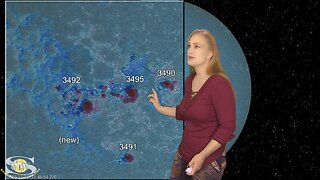Premium Only Content

The Sun Blows a Smoke Ring | Space Weather News 03.24.2020
This Space Weather News forecast sponsored in part by Millersville University:
https://www.millersville.edu/swen
We are coming down from a mild solar storm that has brought aurora both to high latitudes and briefly to mid-latitudes over this past week. Photographers at high-latitudes will likely get aurora continuing over the next few days, however mid-latitude photographers will have to wait for the next chance, which should come in a little over a week from now. On a real positive note, the Sun launched one of the largest solar storms we have seen in a while. Don't worry, it's not Earth-directed, but it is a gorgeous version of what we call a "solar slinky" which looks very similar to a smoke ring, when viewed down the tube of the slinky. Seeing solar storms like this is an indicator that the Sun's magnetic field is growing in strength, which is just one more sign we are continuing to rise out of solar minimum. Solar flux also continues to hold steady in the low 70's despite us having a spotless Sun right now. This means marginal radio propagation on Earth's dayside continues this week. GPS reception should also be improving, especially on Earth's nightside as the solar storm weakens, while dayside GPS reception should remain top notch. Lean the details of the smoke ring solar storm, when and where to see aurora, and what else our Sun has in store this week.
Want early access to these forecasts, tutorials on Space Weather, & more? Visit:
https://patreon.com/SpaceweatherWoman
For daily and often hourly updates (during active times) visit me on Twitter:
https://twitter.com/TamithaSkov
For a more in-depth look at the data and images highlighted in this video see these links below.
Solar Imaging and Analysis:
SDO: http://sdo.gsfc.nasa.gov/data/
Helioviewer: http://www.helioviewer.org/
Flare Analysis: http://www.lmsal.com/solarsoft/latest_events/
Computer Aided CME Tracking CACTUS: http://www.sidc.oma.be/cactus/out/latestCMEs.html
GOES Xray: http://www.swpc.noaa.gov/rt_plots/xray_1m.html
SOHO: http://sohodata.nascom.nasa.gov/
Stereo: http://stereo.gsfc.nasa.gov/
GONG magnetic field synoptic movie: https://gong.nso.edu/data/magmap/standard_movie.html
GONG magnetic field synoptic charts: http://gong.nso.edu/data/magmap/
LMSAL Heliophysics Events HEK http://www.lmsal.com/isolsearch
Solar Wind:
DISCOVR solar wind: http://www.swpc.noaa.gov/products/real-time-solar-wind
ACE Solar Wind: http://www.swpc.noaa.gov/products/ace-real-time-solar-wind
NASA ENLIL SPIRAL: https://iswa.gsfc.nasa.gov/IswaSystemWebApp/iSWACygnetStreamer?timestamp=2038-01-23+00%3A44%3A00&window=-1&cygnetId=261
NOAA ENLIL SPIRAL: http://www.swpc.noaa.gov/products/wsa-enlil-solar-wind-prediction
Magnetosphere, Ionosphere, Atmosphere:
GOES Magnetometer: http://www.swpc.noaa.gov/products/goes-magnetometer
Ionosphere D-Region Absorption (DRAP) model: http://www.swpc.noaa.gov/products/d-region-absorption-predictions-d-rap/
Auroral Oval Ovation Products: http://www.swpc.noaa.gov/products/aurora-30-minute-forecast
Global 3-hr Kp index: http://www.swpc.noaa.gov/products/planetary-k-index
Wing Kp index prediction: http://www.swpc.noaa.gov/products/wing-kp
USGS Ground Magnetometers: http://geomag.usgs.gov/realtime/
USGS Disturbance Storm-Time (Dst): http://geomag.usgs.gov/realtime/dst/
NAIRAS Radiation Storm Model: http://sol.spacenvironment.net/raps_ops/current_files/globeView.html
Multi-Purpose Space Environment Sites:
NOAA/SWPC: http://www.swpc.noaa.gov
SOLARHAM: http://www.solarham.net/index.htm
Spaceweather: http://spaceweather.com
iSWA: http://iswa.gsfc.nasa.gov/iswa/iSWA.html
Definition of Geomagnetic Storm, Radiation Storm, and Radio Blackout Levels:
http://www.swpc.noaa.gov/NOAAscales/
None of this would be possible without the hard work and dedication of those who have provided all of this data for public use.
Images c/o NASA/ESA/CSA (most notably the superb SDO, SOHO, ACE, STEREO, CCMC, JPL & DSN teams, amazing professionals, hobbyists, institutions, organizations, agencies and amateurs such as those at the USAF/HAARP, NICT, NOAA, USGS, Environment Canada, Natural Resources Canada, Intellicast, Catatania, rice.edu, wisc.edu, sonoma.edu ucalgary.ca, rssi.ru, ohio-state.edu, solen.info, and more. Thanks for making Space Weather part of our every day dialogue.
-
 16:00
16:00
Dr. Tamitha Skov
1 year ago $0.06 earnedBig Solar Flares & Solar Storms on the Menu | Solar Storm Forecast 23 November 2023
3485 -
 LIVE
LIVE
The Dana Show with Dana Loesch
40 minutes agoThe Dana Show | 01-22-25
307 watching -
 58:20
58:20
The Dan Bongino Show
4 hours agoPresident Trump Did More In A Day Than Others Did In Two Terms (Ep. 2406) - 01/22/2025
512K613 -
 57:21
57:21
Russell Brand
3 hours agoBREAK BREAD EP. 11 - NATHAN FINOCHIO
82.1K3 -
 2:02:32
2:02:32
Steven Crowder
4 hours agoNon-Stop Winning: How Trump Axed DEI & the Unholy Sermon at the National Cathedral
351K280 -
 59:11
59:11
The Rubin Report
2 hours agoWatch the Moment Charlamagne tha God Realizes Dems Have Been Lying the Whole Time
39.3K38 -
 3:32:27
3:32:27
Right Side Broadcasting Network
23 hours agoLIVE REPLAY: RSBN Post-Inauguration Coverage - 1/22/25
113K14 -

LFA TV
17 hours ago$3 TRILLION IN 3 DAYS! | LIVE FROM AMERICA 1.22.25 11am
30.2K14 -
 LIVE
LIVE
Grant Stinchfield
1 hour agoD.C. Judge Defies Trump! J6ers Still Being Held Hostage Despite Pardon!
497 watching -
 LIVE
LIVE
The Shannon Joy Show
2 hours ago🔥🔥WARP SPEED 2.0 On Steroids! Trump Announces STARGATE ‘The LARGEST AI Infrastructure Project In History’ To Expand mRNA Tech & Surveillance🔥🔥
429 watching